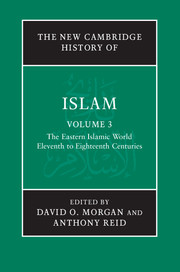Book contents
- Frontmatter
- Introduction: Islam in a plural Asia
- PART I THE IMPACT OF THE STEPPE PEOPLES
- PART II THE GUNPOWDER EMPIRES
- 6 Iran under Safavid rule
- 7 Islamic culture and the Chinggisid restoration: Central Asia in the sixteenth and seventeenth centuries
- 8 India under Mughal rule
- PART III THE MARITIME OECUMENE
- PART IV THEMES
- Glossary
- Bibliography
- Index
- References
7 - Islamic culture and the Chinggisid restoration: Central Asia in the sixteenth and seventeenth centuries
from PART II - THE GUNPOWDER EMPIRES
Published online by Cambridge University Press: 28 March 2011
- Frontmatter
- Introduction: Islam in a plural Asia
- PART I THE IMPACT OF THE STEPPE PEOPLES
- PART II THE GUNPOWDER EMPIRES
- 6 Iran under Safavid rule
- 7 Islamic culture and the Chinggisid restoration: Central Asia in the sixteenth and seventeenth centuries
- 8 India under Mughal rule
- PART III THE MARITIME OECUMENE
- PART IV THEMES
- Glossary
- Bibliography
- Index
- References
Summary
At the beginning of the sixteenth century, the Timurids were ousted from Central Asia and a new era of Chinggisid politics began. Although the Timurids had nominally recognised the sovereign rights of descendants of Chinggis Khan, that recognition had waned as the fifteenth century progressed. Chinggisid rule was restored in Transoxania and Cisoxania (Mawarannahr and Balkh) by a direct descendant of Jochi the eldest son of Chinggis Khan, Muḥammad Shibaq (var. Shāh Beg, Shāh Bakht, Shaybak), but better known by his nom de plume of ‘Shbn’. His line went back to Jochi through the latter’s third son, Shbn, hence the dynastic name Shibanid. Muḥammad Shibani’s clan took its name, Abu’l-Khayrid, from his grandfather. A collateral (and rival) line of Shbnids, the ʿArabshāhid, established itself in Khwārazm at about the same time. The Shbnids of Mwarnnahr and Balkh ruled until 1599 at which point another Jochid line, claiming descent from the thirteenth son of Jochi, Tuqy Temür, took power and remained sovereign there until the mid-eighteenth century. The ʿArabshāhids remained sovereign in Khwārazm until the early eighteenth century.
During these two and a half centuries, the Chinggisids operated within an appanage system of government in which every male member of the ruling clan was entitled to a share in the territory held by the clan. Presiding over the entire polity was a khan, chosen on the basis of seniority and with little real authority outside his own appanage.
- Type
- Chapter
- Information
- The New Cambridge History of Islam , pp. 239 - 265Publisher: Cambridge University PressPrint publication year: 2010



